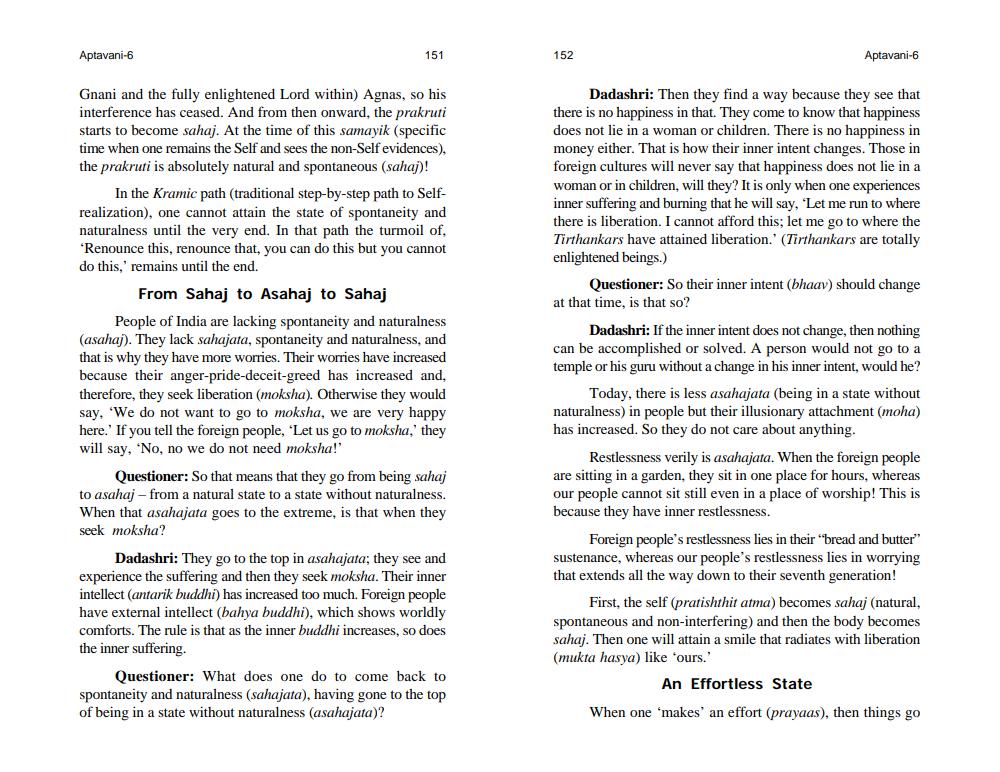________________
Aptavani-6
151
Gnani and the fully enlightened Lord within) Agnas, so his interference has ceased. And from then onward, the prakruti starts to become sahaj. At the time of this samayik (specific time when one remains the Self and sees the non-Self evidences), the prakruti is absolutely natural and spontaneous (sahaj)!
In the Kramic path (traditional step-by-step path to Selfrealization), one cannot attain the state of spontaneity and naturalness until the very end. In that path the turmoil of, *Renounce this, renounce that, you can do this but you cannot do this,' remains until the end.
From Sahaj to Asahaj to Sahaj
People of India are lacking spontaneity and naturalness (asahaj). They lack sahajata, spontaneity and naturalness, and that is why they have more worries. Their worries have increased because their anger-pride-deceit-greed has increased and, therefore, they seek liberation (moksha). Otherwise they would say, 'We do not want to go to moksha, we are very happy here.' If you tell the foreign people, 'Let us go to moksha,' they will say, 'No, no we do not need moksha!'
Questioner: So that means that they go from being sahaj to asahaj - from a natural state to a state without naturalness. When that asahajata goes to the extreme, is that when they seek moksha?
Dadashri: They go to the top in asahajata; they see and experience the suffering and then they seek moksha. Their inner intellect (antarik buddhi) has increased too much. Foreign people have external intellect (bahya buddhi), which shows worldly comforts. The rule is that as the inner buddhi increases, so does the inner suffering.
Questioner: What does one do to come back to spontaneity and naturalness (sahajata), having gone to the top of being in a state without naturalness (asahajata)?
152
Aptavani-6
Dadashri: Then they find a way because they see that there is no happiness in that. They come to know that happiness does not lie in a woman or children. There is no happiness in money either. That is how their inner intent changes. Those in foreign cultures will never say that happiness does not lie in a woman or in children, will they? It is only when one experiences inner suffering and burning that he will say, 'Let me run to where there is liberation. I cannot afford this; let me go to where the Tirthankars have attained liberation.' (Tirthankars are totally enlightened beings.)
Questioner: So their inner intent (bhaav) should change at that time, is that so?
Dadashri: If the inner intent does not change, then nothing can be accomplished or solved. A person would not go to a temple or his guru without a change in his inner intent, would he?
Today, there is less asahajata (being in a state without naturalness) in people but their illusionary attachment (moha) has increased. So they do not care about anything.
Restlessness verily is asahajata. When the foreign people are sitting in a garden, they sit in one place for hours, whereas our people cannot sit still even in a place of worship! This is because they have inner restlessness.
Foreign people's restlessness lies in their "bread and butter" sustenance, whereas our people's restlessness lies in worrying that extends all the way down to their seventh generation!
First, the self (pratishthit atma) becomes sahaj (natural, spontaneous and non-interfering) and then the body becomes sahaj. Then one will attain a smile that radiates with liberation (mukta hasya) like 'ours.'
An Effortless State
When one 'makes' an effort (prayaas), then things go




